Abstract
Nitrogen, phosphorus, potassium and sulfur are main mineral elements that affect yield and quality in fibre plant production. Experiments to determine the effects of four nitrogen (0, 50, 75 and 100 kg/ha), four phosphorus (0, 5, 10 and 15 kg/ha), four potassium (0, 30, 60 and 90 kg/ha) and three sulfur (0, 10 and 20 kg/ha) levels to increase fibre yield and quality of BJRI tossa (Corchorus olitorius) pat 6 plants were conducted in a field experiment. Plant height and stick yield were significantly affected by nitrogen applications. Higher rate of potassium fertilization impact upon plant height and fibre yield was observed. Nitrogen significantly increased fibre yield of plants. Fibre yield was reduced with the highest dose of phosphorus in comparison to yield by the supreme dose of nitrogen. It was concluded that nitrogen mostly improved plant growth and fibre yield while the increase in the level of phosphorus does not have an effect on the increase in yield of fibre and stick.
Keywords
Corchorus olitorius; BJRI Tossa pat 6; Nitrogen; Phosphorus; Potassium; Sulfur fertilizers
Introduction
Jute is the principal bast fibre crop of the World and a matter of pride to Bangladesh. Bangladesh and India produce over 92% of the total jute fibre of the world. In world trade, raw jute signifies fibre produced from two jute species, Corchorus capsularis (white jute) and Corchorus olitorius (tossa jute) and one mesta species Hibiscus cannabinus (Kenaf). Although mesta fibre is obtained from two species, roselle (H. sabdariffa) and kenaf (H. cannabinus), the former is primarily used for production of jams and jellies from calyx. The major jute growing areas in Bangladesh are Faridpur, Jessore, Manikganj, Kishoregan, Mymensingh and Rangpur regions. Corchorus olitorius, belongs to the family-Tiliaceae. It is one of the most popular fibre crops in every districts of Bangladesh. Corchorus olitorius is mainly known for its fibre product, jute and for its leafy vegetables [1]. Several species of Corchorus are used as vegetable, of which Corchorus olitorius is most frequently cultivated. C. olitorius is consumed as a healthy vegetable in Japan, because it contains abundant carotenoids, vitamin B1, B2, C and E, and minerals. On the other hand, accidental death of cattle has occurred when the cattle were feed with vegetation containing the seeds, because the seeds contain cardiac glycoside [2]. The dark-green leaves of C. olitirius have varying proportion of Ca, Fe, -carotene, vitamin C, fibre and protein required for health [1,3]. Nutrition is an important aspect of Jute production system and this includes adequate supply of essential nutrients like nitrogen, phosphorus, potassium, sulfur etc to the plant. The availability of these nutrients to plant contributes a lot to its growth and yield. Therefore adequate amount of nutrients need to be supplied to plant at the right quantity and also at the right time to favour both growth and yield. NPKS have influence on the growth and yield of fibre crops [4- 34]. Fertilizer studies showed positive responses of Corchorus olitorius to nitrogen [35]. Phosphorus is important in root development and helps hasten maturity of the fruit. Soils require extraneous inputs of phosphorus for optimum Corchorus olitorius growth [36]. The role of nitrogen and phosphorus in crop fertilization, leading to increased absorption of elements can be attributed to increase top growth particularly as a result of nitrogen absorption [37]. Similarly, application of any essential element should have a marked effect on yield if the soils were deficient in the element. It is, therefore, necessary to determine the growth and yield performance of a Corchorus olitorius variety BJRI Tossa pat 6 as affected by NPKS fertilizers application.
Materials and Methods
The experiment was conducted at Jute Agriculture Experimental Station of Bangladesh Jute Research Institute. The experiment was laid out in randomized complete block design with three replications. A total of 10 treatment combinations along with a control were distributed randomly in each equal plot as one replication. Each replication was divided into 10 unit plots. At the time of final land preparation, the land was well prepared and fertilizers were applied as per treatment (Table 1). NPKS fertilizers were applied in the form of urea, TSP, MAP and gypsum respectively.
| Treatment |
Nitrogen (kg/ha) |
Phosphorus (kg/ha) |
Potassium (kg/ha) |
Sulfur (kg/ha) |
| T1 |
00 |
00 |
00 |
00 |
| T2 |
50 |
05 |
30 |
10 |
| T3 |
75 |
05 |
30 |
10 |
| T4 |
100 |
05 |
30 |
10 |
| T5 |
75 |
10 |
30 |
10 |
| T6 |
75 |
15 |
30 |
10 |
| T7 |
75 |
05 |
60 |
10 |
| T8 |
75 |
05 |
90 |
10 |
| T9 |
75 |
05 |
30 |
20 |
| T
10 |
75 |
05 |
30 |
00 |
Table 1: Treatment combinations of N, P, K, S
Half of urea was applied at sowing and the rest half was top dressed at 45 days after sowing while all other fertilizers were applied at the time of sowing. At harvesting time, ten plants were selected at random from each plot and tagged in the field to make a note of yield and yield contributing parameters. (Data Source: Annual report, Agriculture Research on Jute: 2008-2009. Bangladesh Jute Research Institute, pp. 78-80)
Results and Discussion
Nitrogen, phosphorus, potassium and sulfur are main essential elements for most of the biological processes in a plant. Their individual effects and interactions on fibre plants were investigated in many studies [38- 41]. Root development, dry matter production and other plant functions regulating crop yield and quality are improved by nitrogen interactions with potassium [42]. In the present study, the different results noticed that application of higher dose of fertilizer influenced on growth and yield of fibre production of the variety BJRI Tossa pat 6 (Figures 1-4).
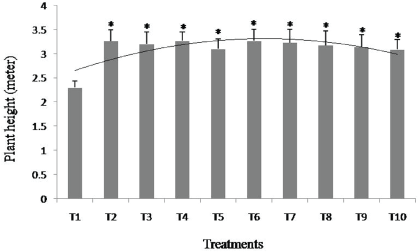
Figure 1: Plant height of the variety BJRI Tossa Pat 6 using different chemical fertilizer treatments. Each datum was calculated from three independent experiments. The results are expressed as the mean ± S.E.M. *p<0.05 significance by the Student’s t-test.
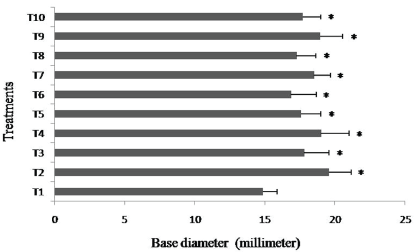
Figure 2: Base diameter of the variety BJRI Tossa Pat 6 using different chemical fertilizer treatments. Each datum was calculated from three independent experiments. The results are expressed as the mean ± S.E.M. *p<0.05 significance by the Student’s t-test.
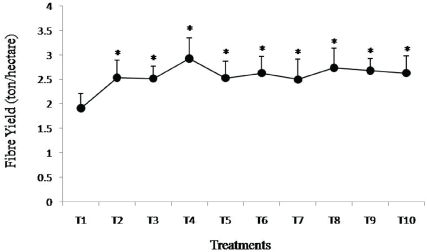
Figure 3: Fibre yield of the variety BJRI Tossa Pat 6 using different chemical fertilizer treatments. Each datum was calculated from three independent experiments. The results are expressed as the mean ± S.E.M. *p<0.05 significance by the Student’s t-test.
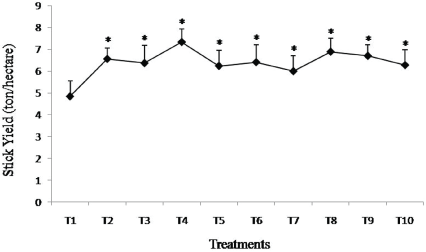
Figure 4: Stick yield of the variety BJRI Tossa Pat 6 using different chemical fertilizer treatments. Each datum was calculated from three independent experiments. The results are expressed as the mean ± S.E.M. *p<0.05 significance by the Student’s t-test.
The plant height, base diameter, yield of fibre and stick were influenced over control by different incremental doses of nitrogen. The N dose 100 kgN/ha provided the best results for the mentioned parameters (Figures 1-4).
The highest plant height was observed with supreme dose of phosphorus 15 kgP/ha (T6 ). The yield of fibre was reduced (T6 ) with highest dose of 15 kgP/ha in comparison to supreme dose of nitrogen. The highest dose of Phosphorus (T6 ) produced lower stick yield. However the effect of P was not much pronounced either on fibre and stick yield due to the incremental doses.
The average plant height, base diameter and stick yield were obtained by 30, 60 and 90 kg K/ha respectively. In case of fibre yield highest dose of K 90 kg/ha (T8 ) yielded highest over all the treatments except the yield found by treatment T4 . It is evidence in producing higher rate of fibre needs potassic fertilizer [4,26-31].
There were used three doses of sulfur viz. 0, 10, and 20 kg/ha. It was observed from the result that higher dose of S (20 kg/ha) decreased the plant height (T9 ) in compare to 10 kg S/ha (T3 ). Although the fibre yield was increased with increasing doses of sulfur. Higher dose of sulfur (20 kg S/ha) produced higher fibre yield (T9 ) compared to control, but 10 Kg S/ ha produced significantly highest yield (T4 ). Stick yield also showed similar trend of result.
Highest fibre yield and stick yield were obtained with T4 (N100P5K30S10 kg/ha) treatment. The nutrient combination and their ratio is one of the key factors for BJRI Tossa pat 6 production that is supported by previous report [4,32,33].
Economic analysis was done considering the variable cost of fertilizers, seeds, labor and price of fibre and stick. The highest gross return (Figures 5 and 6), gross margin (Figure 7) and benefit cost ratio (Figure 8) were found with the treatment T4 . This reveals that T4 treatment was the most cost effective treatment as it gives the highest benefit cost ratio which is highly profitable. This result is due to efficient supervision and management practices (Figure 9).
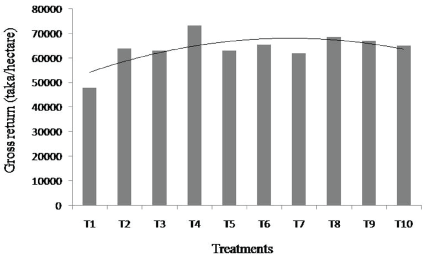
Figure 5: Gross return (Tk/ha) for the production of BJRI Tossa Pat 6
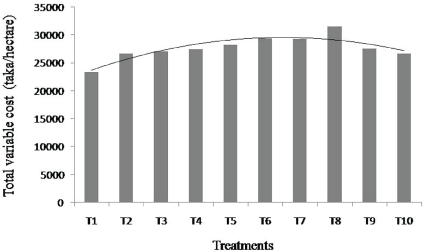
Figure 6: Total variable cost (Tk/ha) for the production of BJRI Tossa Pat 6
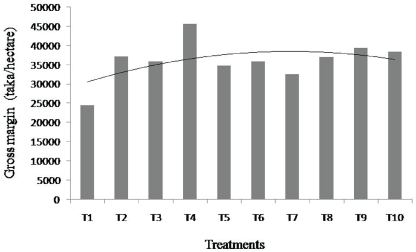
Figure 7: Gross margin (Tk/ha) for the production of BJRI Tossa Pat 6
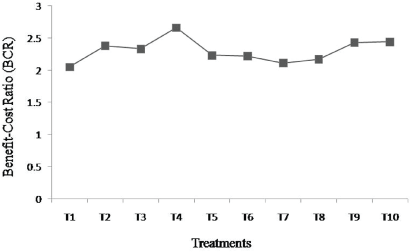
Figure 8: Benefit-cost ratio for the production of BJRI Tossa Pat 6
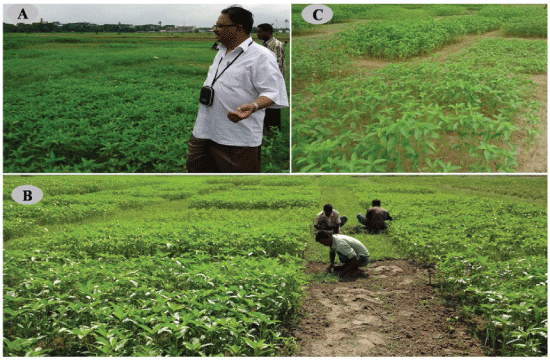
Figure 9: Intercultural operations; (A) Supervision suggesting for intercultural operations, (B) intercultural operations activities, (C) After intercultural operations
Conclusions
The present study outlined specific effects of NPKS fertilization on growth and yield of BJRI Tossa pat 6. Taking into account the results of fibre yield and economic analysis, combination of N100P5K30S10 kg/ha showed better performance for BJRI Tossa pat 6. Nitrogen significantly increased fibre yield but highest dose of phosphorus reduced fibre yield in comparison to supreme dose of nitrogen. Further investigations are thus still required to understand response of BJRI Tossa pat 6 (Figure 10) to mineral fertilization.
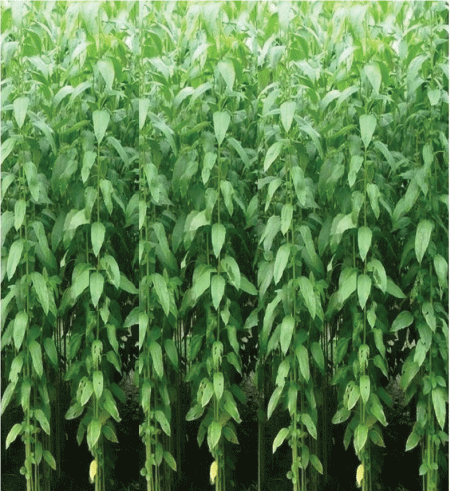
Figure 10: BJRI Tossa Pat 6 plant
Author Contribution
Md.SA performed the research work and wrote the manuscript; Md.NG and Md.MI supervised the program.
Conflict of Interest
The authors declare that they have no competing interests.
Acknowledgements
Thanks to Jute Agriculture Experimental Station of BJRI and valuable assistance of Mrs. Suraiya Khandker (CSO), Dr. AKM Maqsudul Alam (CSO) and Dr. Md. Monjurul Alam (DG, BJRI) are acknowledged.
Article Information
Article Type: Research Article
Citation: Ali MS, Gani MN, Islam MM (2017) Nutrient Management on Growth and Yield of BJRI Tossa Pat 6. Nutr Food Technol Open Access 3(3): doi http://dx.doi.org/10.16966/2470-6086.147
Copyright: © 2017 Ali MS, et al. This is an open-access article distributed under the terms of the Creative Commons Attribution License, which permits unrestricted use, distribution, and reproduction in any medium, provided the original author and source are credited.
Publication history:
Received date: 11 Oct 2017
Accepted date: 14 Dec 2017
Published date: 20 Dec 2017











